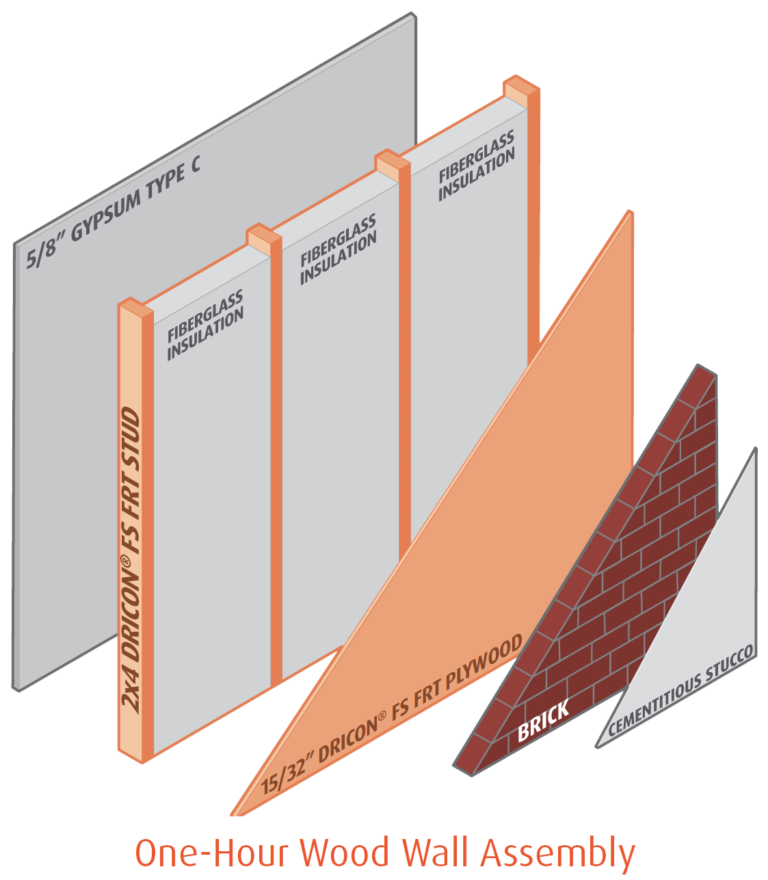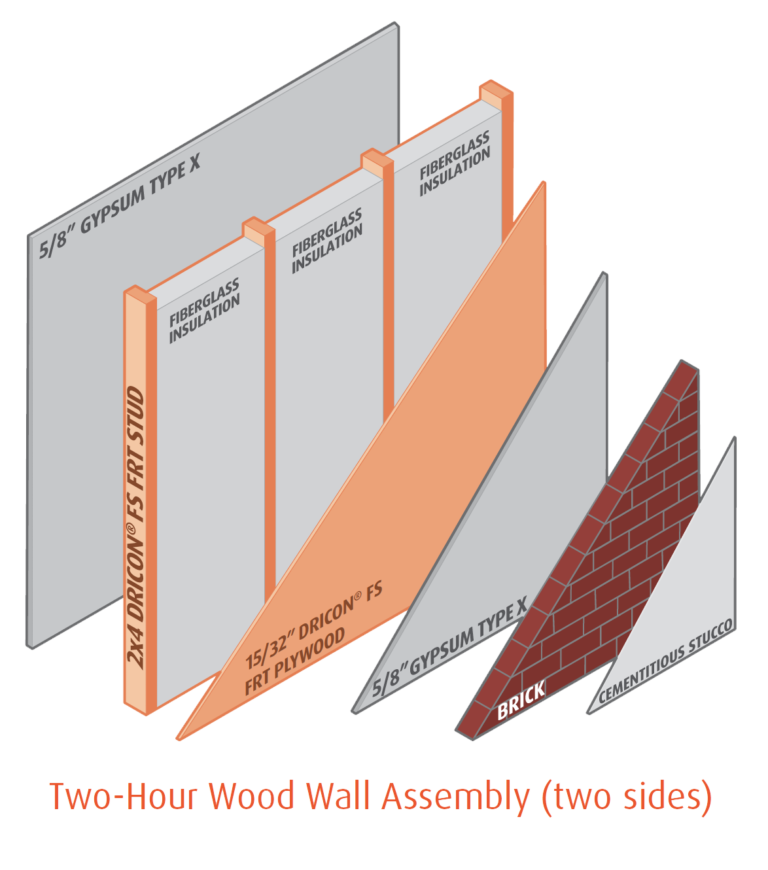Dricon® FS Rated Assemblies
Fire Resistance - Hourly Ratings
Recent testing has provided effective and competitive designs for one hour rated floor/ceiling and roof/ceiling metal-plate-connected wood trusses. Unlike earlier designs, the one hour rating can now be achieved with only one layer of 5/8” Type C gypsum wallboard applied directly to the bottom chord of the truss.
Dricon® FS FRTW can be used in place of untreated wood in many of these designs and will enable the use of these assemblies in many building construction types that do not permit untreated wood. These new construction assemblies provide greater savings than ever before when Dricon® FS wood construction is substituting for hourly rated steel or concrete construction.
One-Hour Wood Truss or Ceiling Assemblies
Recent testing has provided effective and competitive designs for one hour rated floor/ceiling and roof/ceiling metal-plate-connected wood trusses. Unlike earlier designs, the one hour rating can now be achieved with only one layer of 5/8” Type C gypsum wallboard applied directly to the bottom chord of the truss.
Dricon® FS FRTW can be used in place of untreated wood in many of these designs and will enable the use of these assemblies in many building construction types that do not permit untreated wood. These new construction assemblies provide greater savings than ever before when Dricon® FS wood construction is substituting for hourly rated steel or concrete construction.
One and Two Hour Wood Wall Assemblies
Dricon® FS FRTW has receive-d 1- and 2-hour fire resistance ratings for load-bearing exterior wall assembly. The materials of construction for the assemblies include 1 or 2 layers 5/8 Type C or Type X gypsum, fiberglass insulation, Dricon® FS FRTW studs (2×4), 15/32 inch Dricon® FS FRTW plywood and your choice of exterior finishes.
2-hour load bearing wall using gypsum Type X
2-hour load bearing wall when tested from the interior face and 1-hour rating when tested from the exterior face
1-hour load bearing wall tested from the interior face
1-hour load bearing wall tested from the exterior face



Fire Resistance - Hourly Ratings
Fire retardant treated wood has a surface burning classification and, by itself, does not have a resistance rating in hours any greater than untreated wood. Fire ratings in hours are assigned to door, wall, or deck assemblies, following testing in accordance with ASTM E 119. References such as the Underwriters Laboratories “Fire Resistance Directory” specifically point out that FRT wood may be substituted for untreated wood in any rated assembly. Dricon® FS FRTW can be used as a component of such assemblies in structures where the code does not permit the use of untreated wood. For additional building code guidance for fire retardant treated wood, please reference the 2018 International Building Code Chapter 6 for allowances based on construction classification.
Descriptions of fire resistance rated assemblies incorporating structural lumber are listed in several publications, with the following being those generally referenced in model building codes:
Fire Resistance Directory, published by Underwriters Laboratories
Fire Resistance Ratings, published by Engineering and Safety Service of the American Insurance Service Group
Fire Resistance Design Manual, published by the Gypsum Association
For example, the Gypsum Association’s “Fire Resistance Design Manual” shows a one hour wall or partition assembly (WP 3605) that has wood studs covered by 5/8” Type X gypsum board with specified nailing and positioning of the panels. This assembly could be used for interior, non-bearing partitions, requiring a one hour rating in a noncombustible structure if the studs were Dricon® FS FRTW. In a similar manner, by substituting Dricon® FS FRTW for untreated wood, other one and two hour wall and ceiling assemblies can be used in noncombustible type buildings. The model codes also permit use of ceiling assemblies with the top membrane omitted where only unused attic space is above.
Some model codes and local building officials will accept the Component Additive Method (CAM) for calculating fire resistance in lieu of actual assembly testing. The CAM concept entails adding the resistance rating of individual components to qualify the resistance rating of the assembly. See next page for an example.
The lumber and plywood used in rated assemblies or CAM listings are usually not identified as being untreated or FRT wood, but the model codes generally do require that any wood used in noncombustible types of construction be fire retardant treated.
Also, due to wood’s natural ability to insulate, wood may be more acceptable than unprotected steel in fire resistant assemblies.
